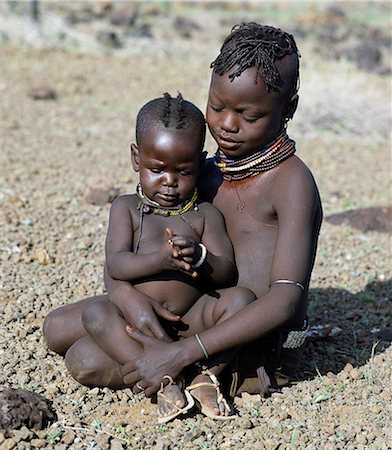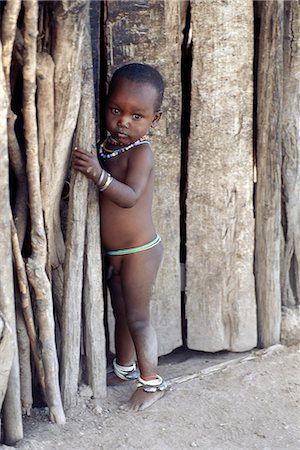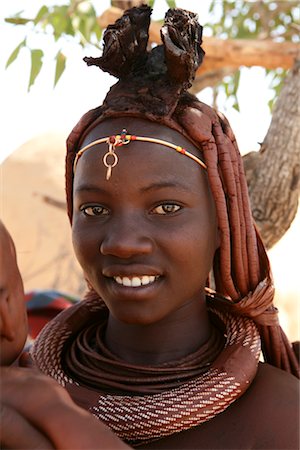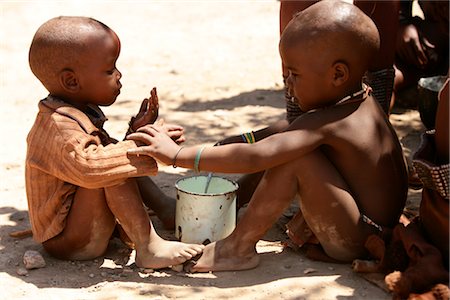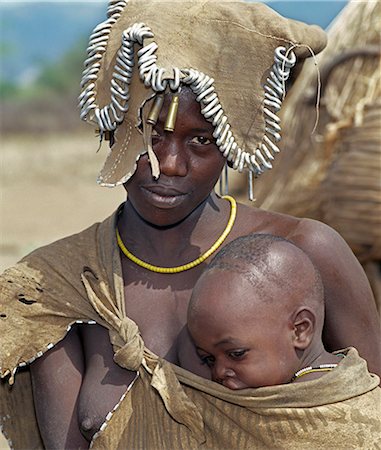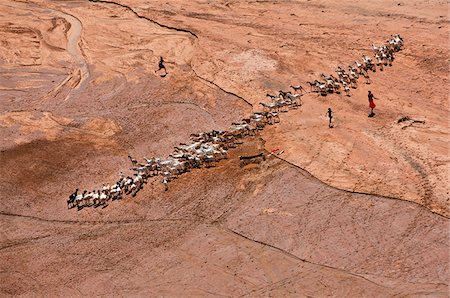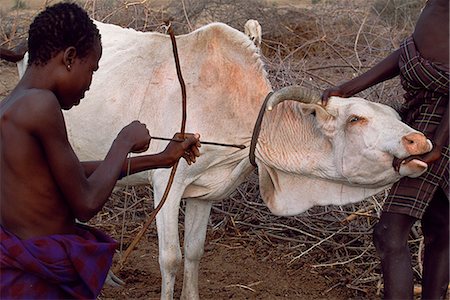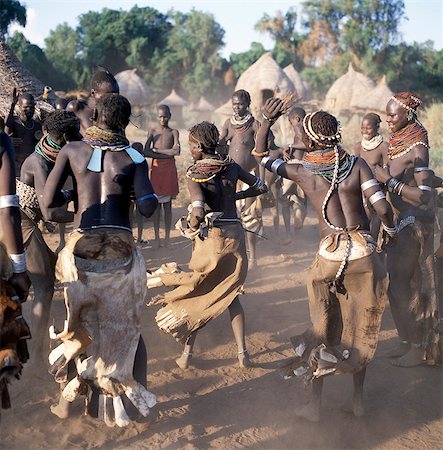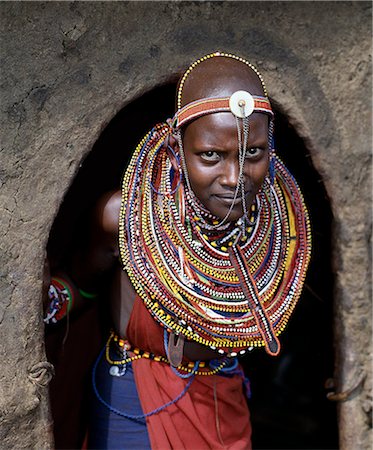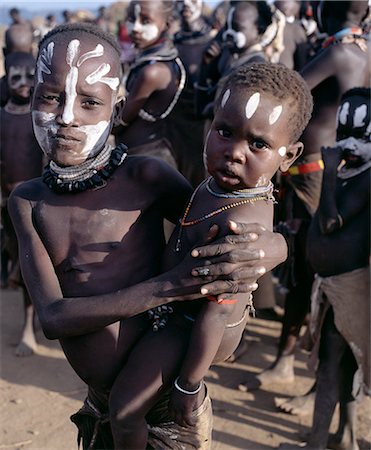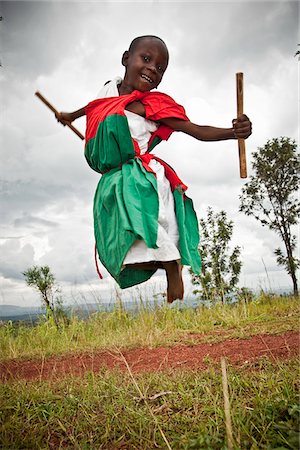-
Red Ochre (or ocher stone) pigment used by Himba to create a reddish tint, Kaokoveld, Namibia, Africa
Rights-Managed
-
A young Maasai girl wearing a wooden plug in her pierced ear to elongate the earlobe. It has been a tradition of the Maasai for both men and women to pierce their ears and elongate their lobes for decorative purposes. Her two lower incisors have been removed - a common practice that may have resulted from an outbreak of lockjaw a long time ago.
Rights-Managed
-
Chad, Kanem, Bahr el Ghazal, Sahel. Kreda girls and boys congregate at the water pump outside their village.
Rights-Managed
-
In the early morning,a Maasai herdsboy and his sister drive their family's flock of sheep across the friable,dusty plains near Malambo in northern Tanzania.
Rights-Managed
-
The fetching hairstyle of a young Afar girl. Proud and fiercely independent,the nomadic Afar people live in the low-lying deserts of Eastern Ethiopia.
Rights-Managed
-
A young Turkana boy looks pensive as he holds a large gourd. Gourds are less common with the Turkana than the wooden containers their women make; firstly,they are expensive since they have to be brought from afar but more importantly they crack more easily on the move.
Rights-Managed
-
Childhood is brief in nomadic communities. From an early age,Turkana girls help their mothers with the household chores and look after their younger brothers and sisters during the day. The baby has wooden charms round her neck to ward off evil spirits.
Rights-Managed
-
Young Maasai girls decorate their faces with ochre and clay in preparation for a dance.
Rights-Managed
-
A Hadza boy carrying a bow and arrows. The Hadzabe are a thousand-strong community of hunter-gatherers who have lived in the Lake Eyasi basin for centuries. They are one of only four or five societies in the world that still earn a living primarily from wild resources.
Rights-Managed
-
Chad, Kanem, Bahr el Ghazal, Sahel. A Kreda woman leads a camel with her daughter and young child riding on top of it.
Rights-Managed
-
A young Datoga boy attired in beads. The metal bells worn around his ankles ensure that he does not wander far from home without his mother or another member of the family hearing him. The Datoga (known to their Maasai neighbours as the Mang'ati and to the Iraqw as Babaraig) live in northern Tanzania and are primarily pastoralists.
Rights-Managed
-
A young Dassanech girl holds her little brother. She wears a leather skirt with an elaborate fringe of wooden and metal tassles. Much the largest of the tribes in the Omo Valley numbering around 50,000,the Dassanech (also known as the Galeb,Changila or Merille) are Nilotic pastoralists and agriculturalists.
Rights-Managed
-
Primary school of the Leparua people, providing education as well as medication, Kenya, East Africa, Africa
Rights-Managed
-
A young Maasai girl wears a headband decorated with chains and cowrie shells that signifies her recent circumcision. Clitodectomy was commonly practiced by the Maasai but it is now gradually dying out.
Rights-Managed
-
A Hamar woman sits on the ground breast-feeding her baby in the village square of Dimeka. Married women wear two heavy steel necklaces. This woman wears an extra necklace with steel a steel phallic symbol which identifies her as a first wife. She also wears a goatskin capefringed with cowrie shells and her hair long in a braided fringe matted with animal fat and ochre.
Rights-Managed
-
A pretty tousle-haired girl of the nomadic Afar tribe wears bright colours in stark contrast to the drab,windswept surroundings of Lake Abbe.
Rights-Managed
-
A young Dassanech boy with an elaborate clay hairdo and headband of beads at his village in the Omo Delta. Much the largest of the tribes in the Omo Valley numbering around 50,000,the Dassanech (also known as the Galeb,Changila or Merille) and Nilotic pastoralists and agriculturalists.
Rights-Managed
-
Two young Datoga boys. The youngest wears metal bells around his ankles to ensure that he does not wander far from home without his mother or another member of the family hearing him. The Datoga (known to their Maasai neighbours as the Mang'ati and to the Iraqw as Babaraig) live in northern Tanzania and are primarily pastoralists.
Rights-Managed
-
Traditional lifestyle of families on courtyards outside of homes, with modern little bike, Tiebele, Burkina Faso
Rights-Managed
-
A happy Turkana boy carries home a Nile perch which he caught in Lake Turkana.
Rights-Managed
-
A Karo woman sits with child. A small Omotic tribe related to the Hamar,who live along the banks of the Omo River in southwestern Ethiopia,the Karo are renowned for their elaborate body painting using white chalk,crushed rock and other natural pigments. Typically for a Karo woman,the mother has ochred her hair in tight ringlets and has a ring through her bottom lip.
Rights-Managed
-
Boy holding toy car, home-made from oil can, near Gaoua, Poni Province, Burina Faso
Rights-Managed
-
A young mother and child of the Arsi-Oromo people west of Aje. Both have unusual hairstyles. The braids falling from the crown of the mother's head have been attractively woven with wool to make a colourful fringe.
Rights-Managed
-
A young Turkana herdsboy sneaks a drink of milk straight from a camel's udder. Camels are important to stockowners in the arid regions of Turkanaland since they are browsers and can be milked up to five times a day
Rights-Managed
-
When a Turkana woman gives birth,four goats will be slaughtered in a twenty-four-hour period to celebrate the occasion. The skin of the first goat will be made into a pouch for carrying the baby on its mother's back. The small wooden balls on the back of this pouch are charms to ward off evil spirits. The baby is wearing a bracelet of ostrich eggshell beads.
Rights-Managed
-
Two jovial Pokot girls set off with leather bags in search of edible berries. Pokot girls and women traditionally wore leather skirts and capes made from home-tanned goatskins. The necklaces of young girls are made from small segments of sedge grass.
Rights-Managed
-
A coy young Dassanech boy with a hairstyle typical of the young boys of his tribe.The Dassanech speak a language of Eastern Cushitic origin. They practice animal husbandry and fishing as well as agriculture.
Rights-Managed
-
A young Turkana girl with her head shaved except for a tuft,which is braided. This is the usual hairstyle for women and girls.
Rights-Managed
-
Woman of the Mursi Tribe with Kalashnikov and small child, Omo Valley, Ethiopia
Premium Royalty-Free
-
A Mursi mother and child.The mother shades her shaven head from the sun with a small decorated leather apron.The Mursi speak a Nilotic language and have affinities with the Shilluk and Anuak of eastern Sudan. They live in a remote area of southwest Ethiopia along the Omo River.
Rights-Managed
-
A Samburu warrior talks to children about the bush on a Cheli & Peacock family safari.
Rights-Managed
-
A young Dassanech girl holds her little brother. She wears a leather skirt with an elaborate fringe of wooden and metal tassles. Much the largest of the tribes in the Omo Valley numbering around 50,000,the Dassanech (also known as the Galeb,Changila or Merille) are Nilotic pastoralists and agriculturalists.
Rights-Managed
-
Young Turkana boys have fun on a traditional raft made of doum palm logs lashed together. The fish held high by one of the boys is a tiger fish; these fish put up a good fight but are unpleasant eating because they have numerous small bones.
Rights-Managed
-
Two Dassanech children relax outside their family home. The dome-shaped construction is covered with hides and mats made from papyrus that grows in the Omo Delta.
Rights-Managed
-
A Nyangatom boy holds a cow whilst another boy draws his bow ready to fire an arrow with a very short head into the artery of the cow so they can bleed it. Several pints of blood will be collected which will then be mixed with milk and drunk by the Nyangatom. The Nyangatom or Bume are a Nilotic tribe of sem nomadic pastoralists who live along the banks of the Omo River in south western Ethiopia.
Rights-Managed
-
Lake Baringo, one of only two freshwater lakes of the Eastern Rift, lies in a shallow basin surrounded by hills where poor agricultural practices have led to bad soil erosion. In consequence, the lakes waters are red with suspended solids.The Il Chamus people live near the lake shores and on the islands.
Rights-Managed
-
A young Maasai girl wears face paint and numerous beaded ornaments in preparation for a dance with warriors.
Rights-Managed
-
A Nyangatom mother and young daughter in typical dress. Rugged skin clothing is still widely used.The Nyangatom are one of the largest tribes and arguably the most warlike people living along the Omo River in Southwest Ethiopia.
Rights-Managed
-
Samburu children water their familys goats at a waterhole dug in a seasonal river bed.
Rights-Managed
-
A proud Turkana father and his young daughter. Both their hairstyles are typical of tribal custom in the west of Turkanaland.
Rights-Managed
-
Kenya, near Marsabit. Two young samburu boys follow their cattle through the arid landscape.
Rights-Managed
-
A family game-viewing from a landrover during a Cheli & Peacock mobile safari.
Rights-Managed
-
Two Karo children stand together,arm in arm. A small Omotic tribe related to the Hamar,who live along the banks of the Omo River in southwestern Ethiopia,the Karo are renowned for their elaborate body painting using white chalk,crushed rock and other natural pigments.
Rights-Managed
-
A Nyangatom boy holds a cow whilst another boy draws his bow ready to fire an arrow with a very short head into the artery of the cow so they can bleed it. Several pints of blood will be collected which will then be mixed with milk and drunk by the Nyangatom. The Nyangatom or Bume are a Nilotic tribe of sem nomadic pastoralists who live along the banks of the Omo River in south western Ethiopia.
Rights-Managed
-
A Samburu moran teaches children the skills of being a warrior during a Cheli & Peacock family mobile safari.
Rights-Managed
-
A lively Nyangatom dance is enjoyed by villagers in the late afternoon.The elevated houses in the background are both homes and granaries, which have been built to withstand flooding when the Omo River bursts its banks The Nyangatom are one of the largest tribes and arguably the most warlike people living along the Omo River in Southwest Ethiopia.
Rights-Managed
-
Three Maasai girls sit on the edge of Shimu la Mungu (a volcanic blow hole known as 'God's hole') with the extinct volcano,Kerimasi,in the distance.
Rights-Managed
-
A Nyangatom woman stands with her baby on her hip beside her grass hut in his temporary camp. Nyangatom married women wear elaborately beaded skirts which reach the ground at the back and often have panels of different coloured calkfskin sewn into the tail The Nyangatom or Bume are a Nilotic tribe of semi nomadic pastoralists who live along the banks of the Omo River in south western Ethiopia.
Rights-Managed
-
A tourist accompanied by a retinue of children in a Dassanech settlement along the lower Omo River. Much the largest of the tribes in the Omo Valley numbering around 50,000,the Dassanech (also known as the Galeb,Changila or Merille) and Nilotic pastoralists and agriculturalists.
Rights-Managed
-
Lake Kyoga is formed by the Victoria Nile in its middle course,and has many arms or tentacles. A shallow lake 10-12 feet deep - with dense floating papyrus fringes,it is an important fish ground for the local people. Most fishing takes place from wooden boats using weighted throwing nets. These young men are returning home with their catch.
Rights-Managed
-
A young Maasai girl in all her finery pauses at the entrance to her mother's home. The wall and roof of the house are plastered with a mixture of cow dung and soil.
Rights-Managed
-
A young Maasai girl keeps the holes in her pierced ears from closing with grass and rolled leaves. She will gradually stretch her earlobes by inserting progressively larger wooden plugs. By tradition,both Maasai men and women pierce and elongate their earlobes for decorative purposes.
Rights-Managed
-
The Karo of the Lower Omo River excel in body art. They decorate their faces and torsos elaborately using local white chalk, pulverised rock and other natural pigments. Even young children daub their faces before a dance.The Karo are a small tribe living in three main villages along the lower reaches of the Omo River in southwest Ethiopia.
Rights-Managed
-
Maasai girls in all their finery and with bells tied round their legs wait at the entrance to a house before dancing with warriors.
Rights-Managed
-
Gitega, Burundi. A young boy performs with the traditional Tambourinares at Gitega museum.
Rights-Managed
-
Children studying during a class taken by VSO volunteer Paul Jennings and local teacher Rebecca Ngovano, Angaza school, Lindi, Tanzania, East Africa, Africa
Rights-Managed
-
An Afar woman adjusts the load on her camel as her young child sits on top. Proud and fiercely independent,the nomadic Afar people live in the low-lying deserts of Eastern Ethiopia. Camels are valuable in these harsh conditions; they carry house structures and personal possessions,enabling families to follow the seasonal pattern of rain and grazing.
Rights-Managed
-
The Pokot have a small ceremony called Koyogho when a man pays his in-laws the balance of the agreed dowry for his wife. At the conclusion of the ritual, his wife is given a large gourd of milk which she carries home on her back with her youngest child.
Rights-Managed
-
Samburu mothers will often carry their babies in bright cotton material tied round their waists or slung on their backs with a knot over one shoulder. Sometimes,coils of brass wire will cover women's upper or lower arms; they may be wound so tightly that movement of the arm is restricted causing the biceps to gradually weaken.
Rights-Managed
-
A young Samburu boy washes himself in a wooden water trough used for the family's livestock. Note the metal bell tied to his right leg. Should he inadvertently wander off into the bush and get lost,the bell will help his family to find him.
Rights-Managed




















